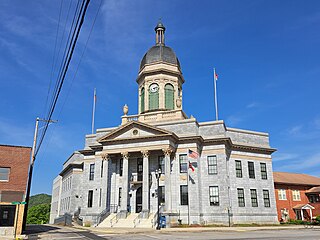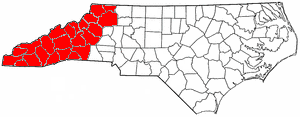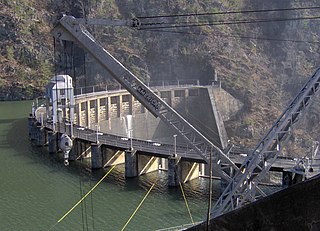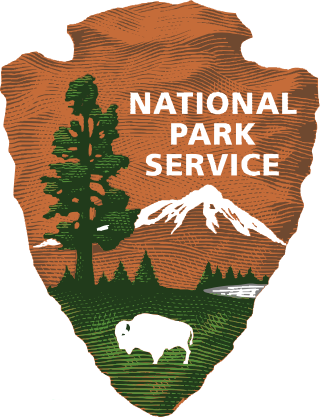
Blount County is a county located in the East Tennessee Grand Division of the U.S. state of Tennessee. As of the 2020 census, its population was 135,280. The county seat is Maryville, which is also the county's largest city. Blount County is included in the Knoxville metropolitan area.

Swain County is a county located on the far western border of the U.S. state of North Carolina. As of the 2020 census, the population was 14,117. Its county seat is Bryson City.

Graham County is a county located in the U.S. state of North Carolina. As of the 2020 census, the population was 8,030, making it the third-least populous county in North Carolina. Its county seat is Robbinsville.

Cherokee County is the westernmost county in the U.S. state of North Carolina. It borders Tennessee to its west and Georgia to its south. As of the 2020 census, the population was 28,774. The county seat is Murphy.

Lake Santeetlah is a town in Graham County, North Carolina, United States, 6 miles (10 km) northwest of Robbinsville on a peninsula surrounded by Lake Santeetlah—which in turn is largely surrounded by Nantahala National Forest. The town has more than two hundred residences, many of them second homes owned by permanent residents of Florida and Georgia. The town was organized in 1989 as "Santeetlah"; in 1999, it changed its name to "Lake Santeetlah". The full-time population was 67 at the 2000 census and dropped to 45 in 2010.

Dillsboro is a town in Jackson County, North Carolina, United States. The population was 213 at the 2020 census down from 232 at the 2010 census.

Bryson City is a town in and the county seat of Swain County, North Carolina, United States. The population was 1,558 as of the 2020 census. Located in what was historically the land of the Cherokee, Bryson City was founded as Charleston to serve as the county seat of Swain County when it was formed from parts of surrounding counties. It grew into an important local rail hub. Today the city serves as a popular tourist destination, lying just to the west of the entrance to the Great Smoky Mountains National Park, for outdoor activities in the Nantahala National Forest, and along the Nantahala River and Fontana Lake, and serves as the home of the Great Smoky Mountains Railroad, a heritage railroad that provides tours of the Nantahala valley. The popular Nantahala Outdoor Center provides guide services for many of the outdoor activities in the area.

The Little Tennessee River is a 135-mile (217 km) tributary of the Tennessee River that flows through the Blue Ridge Mountains from Georgia, into North Carolina, and then into Tennessee, in the southeastern United States. It drains portions of three national forests— Chattahoochee, Nantahala, and Cherokee— and provides the southwestern boundary of the Great Smoky Mountains National Park.

Fontana Dam is a hydroelectric dam on the Little Tennessee River in Swain and Graham counties, North Carolina, United States. The dam is operated by the Tennessee Valley Authority, which built the dam in the early 1940s to satisfy the skyrocketing electricity demands in the Tennessee Valley to support the aluminum industry at the height of World War II; it also provided electricity to a formerly rural area.

Western North Carolina is the region of North Carolina which includes the Appalachian Mountains; it is often known geographically as the state's Mountain Region. It contains the highest mountains in the Eastern United States, with 125 peaks rising to over 5,000 feet in elevation. Mount Mitchell at 6,684 feet, is the highest peak of the Appalachian Mountains and mainland eastern North America. The population of the 23 most commonly associated counties for the region, as measured by the 2020 U.S. Census, is 1,149,405. The region accounts for approximately 11% of North Carolina's total population.

North Carolina Highway 28 (NC 28) is an 81.2-mile-long (130.7 km) primary state highway in the U.S. state of North Carolina. The highway runs north–south through the Nantahala National Forest in Western North Carolina.

Calderwood Dam is a hydroelectric dam located along the Little Tennessee River in Blount and Monroe counties, in the U. S. state of Tennessee. Completed in 1930, the dam is owned and maintained by Tapoco, a subsidiary of the Aluminum Company of America (Alcoa), although the Tennessee Valley Authority (TVA) controls the dam's reservoir levels from Fontana Dam further upstream. Calderwood Dam is named for Alcoa engineer Isaac Glidden Calderwood (1871–1941), who supervised much of the company's early Little Tennessee River operations.

The Cheoah Dam is a hydroelectric dam located in Graham and Swain counties, North Carolina, on the Little Tennessee River between river miles 51 and 52. The Cheoah Development consists of a dam and powerhouse, the first of several constructed by the Tallassee Power Company, a subsidiary of Aluminum Company of America, in order to generate electricity to smelt aluminum in Alcoa, Tennessee.

Fontana Lake is a reservoir impounded by Fontana Dam on the Little Tennessee River, and is located in Graham and Swain counties in North Carolina. The lake forms part of the southern border of Great Smoky Mountains National Park and the northern border of part of the Nantahala National Forest. Depending on water levels, the lake is about 17 miles (27 km) long. The eastern end is the Tuckasegee River near Bryson City. It has an average depth of 135 feet (41 m) and reaches a maximum depth of 440 feet (130 m), making it the deepest lake in North Carolina. The lake has many inlets into coves and many islands formed from former mountain peaks, especially near the eastern end. As with most dam-impounded lakes, the steep banks are exposed when water levels are low. Many towns were submerged shortly after the creation of Fontana Lake, such as Proctor, Judson, and the town of Fontana itself.

Lake Santeetlah, part of the Tennessee River watershed, was created in 1928 when Alcoa dammed the Cheoah River as a means of generating hydroelectric power in Graham County, North Carolina. The reservoir is largely surrounded by the Cheoah District of the Nantahala National Forest. During the last decades of the twentieth century non-public lands were developed as scenic residences and vacation homes, most notably in the area now incorporated as the town of Lake Santeetlah.

Hiwassee Dam is a hydroelectric dam on the Hiwassee River in Cherokee County, in the U.S. state of North Carolina. It is one of three dams on the river owned and operated by the Tennessee Valley Authority, which built the dam in the late 1930s to bring flood control and electricity to the region. The dam impounds the Hiwassee Lake of 6,000 acres (2,400 ha), and its tailwaters are part of Apalachia Reservoir. At 307 feet (94 m), Hiwassee Dam is the highest overspill dam east of the Mississippi River and is second only to Grand Coulee dam in the nation. At the time it was completed, it was the highest overspill dam in the world.
Alcoa Power Generating, Inc. is a subsidiary of Alcoa Inc., headquartered in Pittsburgh, Pennsylvania. Its three divisions were independent subsidiaries before being consolidated into Alcoa Power Generating, Inc. (APGI). These three projects have produced hydroelectric power and manage impoundments which also provide flood control; recreation, residential and business opportunities; and wildlife habitat.
Almond is an unincorporated community in Swain County, North Carolina, United States. Almond is located on the Little Tennessee River and North Carolina Highway 28 7.9 miles (12.7 km) west-southwest of Bryson City.
Caroleen is an unincorporated community and census-designated place (CDP) in southeastern Rutherford County, North Carolina, United States. Its population was 560 as of the 2020 census. Caroleen has a post office with ZIP code 28019. U.S. Route 221 Alternate passes through the community.

Lakeview Drive is a 6.5-mile-long (10.5 km) road in North Carolina, split in two segments, located along the north shore of Fontana Lake, wholly within the Great Smoky Mountains National Park. The scenic road, which was never completed, features an unused road tunnel and connects to various hiking and horse riding trails in the area.






















